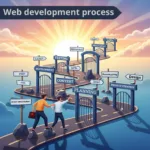-
1.
The ultimate guide to building a buzz
- 1.1. Meet Barnaby Bingley, Manager, Thespian Theatre, Upper Bottomley
- 1.2. Your venue’s digital home—what your website absolutely needs
- 1.3. Lights, camera action! Branding your theatre online
- 1.4. Connecting with your crowd—the power of social media (and how to wield it effectively)
- 1.5. Opening doors to everyone—why digital accessibility matters for a theatre website
- 1.6. Bringing it all together—creating a thriving online ecosystem
- 1.7. Other articles you might find useful for your theatre website
The digital stage is set, and the spotlight is on you. In today’s world a vibrant online presence isn’t just a nice–to–have for theatres. It’s the lifeblood that attracts audiences, fosters community, and ultimately boosts your bottom line. But for busy venue managers juggling countless responsibilities navigating the complexities of theatre websites can seem a daunting backstage drama.
This comprehensive guide will help you to confidently step out of the shadows and onto the digital stage. Soon, you will be basking in the limelight. Specifically, we’ll explore the essential digital strategies that will transform your theatre website and online presence. In consequence of following our advice, your website will change from a source of stress into a powerful tool for success. So, consider this your backstage crew for the digital age. It will provide the foundational knowledge you need to build a real buzz around your venue.
Meet Barnaby Bingley, Manager, Thespian Theatre, Upper Bottomley
Take Barnaby Bingley, the enthusiastic but perpetually flustered manager of the Thespian Theatre in Upper Bottomley, for example. Barnaby embodies the challenges many of you face. One minute he’s wrestling with a temperamental lighting rig, the next he’s trying to decipher the latest social media algorithm. All this while simultaneously fielding calls about ticket availability. His attempts at updating the theatre website eventually result in a confusing jumble of outdated information and broken links. However, he dreams of a thriving online presence, one that showcases the Theatre’s charm and attracts new patrons. But the sheer volume of tasks leaves him feeling like a lone performer in a very large, and technologically demanding, one–man play.
Your venue’s digital home—what your website absolutely needs
Your theatre website is often the first point of contact for potential visitors. In particular, it’s your digital shop window, your 24/7 box office, and the central hub for all information about your venue. A poorly designed or outdated website is like a closed curtain, deterring potential audience members before the show even begins.
Barnaby knows this all too well. His current website features:
- blurry decade–old photos,
- an event calendar that hasn’t been updated since Ted Whitecliffe’s run in 1996, and
- a clunky online booking system that sends more people to the phone line than to the checkout.
So, what does your venue website absolutely need to shine?
- Mobile–first design:
Significantly, the majority of users will browse your site on their smartphones. Consequently, you must ensure your website is responsive and fantastic on all devices. A slow, unfriendly mobile site will shed visitors faster than Barnaby clearing the stage after a messy children’s show. - Clear, up–to–date listings:
Obvious, but crucial—let visitors find information for upcoming events: dates, times, ticket prices, performer details, and compelling descriptions. Barnaby once accidentally listed the village fete as a Shakespearean tragedy — obviously, clear and accurate information is key! - Effortless online booking:
A seamless ticket purchasing process is essential. Integrate a secure, user–friendly booking system that allows customers to select seats, make payments, and receive confirmation. Conversely, complicated booking forms are a sure–fire way to lose potential sales. - High–quality visuals:
Showcase the beauty and atmosphere of your venue with stunning photographs and videos. Give potential visitors a taste of what they can expect. Moreover, invest in professional images that capture the essence of your space. - About us section:
Tell your story! For instance, share your venue’s history, mission, and the people behind the scenes. So, build a connection with your audience. Is the theatre bar named after some obscure past manager? Then let your audience understand their significance. - Contact details:
Chiefly, make it easy for people to contact you and find your theatre through your website. Include the address, phone number, email address, and a map.
Additional options for your theatre website
Additionally, some other options include:
- Search functionality:
A search bar is an invaluable help for users to quickly find what they’re looking for. - Integration with social media:
Make it easy for visitors to connect with your social media channels and share events with their friends.
Is your website feeling a bit like Barnaby’s overflowing filing cabinet? Take the weight of website worries off your mind:
Lights, camera action! Branding your theatre online
Your brand is more than just your logo; it’s the overall impression your venue makes. It’s the feeling people get when they hear your name, see your marketing materials, or visit your space. Effective venue branding online ensures consistency and helps you stand out in a crowded digital landscape.
Barnaby’s branding efforts are… well, let’s just say they’re a work in progress. His marketing materials range from elegant, if slightly faded, posters from the 1950s to hastily printed flyers with a different font on every line (and a few mistakes, usually). This lack of consistency makes it difficult for audiences to recognise and connect with Thespian Theatre.
- Consistent visual identity:
Use the same logo, colours, fonts, and imagery across your website, social media profiles, and all other online materials. This creates a cohesive and recognisable brand. - Develop your brand voice:
Define the tone and personality of your venue. Are you sophisticated and traditional, or quirky and contemporary? In particular, ensure your online communication reflects this voice consistently. - High–quality content:
From website copy to social media posts, ensure your content is well–written, engaging, and reflects your brand values. - Showcase your unique selling proposition (USP):
What makes your venue special? Highlight you unique history, architectural features, types of performances, community involvement, or anything that sets you apart. - Engage with your audience:
Respond to comments and messages on social media, and foster a sense of community around your brand. - Professional photography and videography:
Equally important is investing in high–quality visuals that capture the essence of your venue and its events. These are crucial for showcasing your brand online.
Tired of your online branding looking like Barnaby’s mismatched socks? Let Redcentaur help you create a cohesive and impactful digital brand presence.
Social media platforms offer an unparalleled opportunity to connect directly with your audience, build relationships, and promote your events. However, simply setting up a few profiles and sporadically posting isn’t enough. Effective theatre social media requires a strategic approach.
Barnaby’s attempts at social media often involve posting blurry photos of his lunch or sharing cryptic messages with the result that his followers are left scratching their heads. He understands the potential but lacks the time and know–how to truly harness its power.
- Choose the right platforms:
Identify the platforms where your target audience spends their time. For many venues, this will include Facebook, Instagram, and potentially Twitter or even TikTok. - Share engaging content:
Go beyond simply announcing events. Share behind–the–scenes glimpses, introduce performers, run polls and Q&A sessions, post photos and videos of past events, and create engaging stories. - Interact with your followers:
Respond to comments and messages promptly. Emphatically show your audience that you’re listening and value their engagement. - Use relevant hashtags:
Research and use relevant hashtags to drive traffic to your website and to increase the visibility of your posts and reach a wider audience interested in theatre, live events, and your local area.
- Develop a content calendar:
Plan your social media posts in advance to ensure a consistent flow of engaging content. This will save you from last–minute scrambling like Barnaby trying to find a forgotten prop just before curtain up. - Run targeted advertising:
Social media advertising allows you to reach specific demographics and interests, ensuring your message reaches the right people. - Track your results:
Monitor your social media analytics to see what content performs best and adjust your strategy accordingly.
Feeling overwhelmed by the ever–changing world of social media like Barnaby trying to learn a new dance routine? Redcentaur can help you develop a social media strategy that delivers results.
Opening doors to everyone—why digital accessibility matters for a theatre website
Digital accessibility for venues is not just a legal requirement; it’s about ensuring that everyone, regardless of their abilities, can access your online information and engage with your venue. an inaccessible website can exclude a significant portion of your potential audience.
Barnaby, in his rush to get the website “done,” unfortunately overlooked the importance of accessibility. So, he’s now realising that many potential visitors with visual or auditory impairments are struggling to navigate his site, missing out on the wonderful performances at Thespian Theatre.
Here’s why digital accessibility for venues is crucial and how to achieve it:
- Website accessibility standages (WCAG):
Familiarise yourself with the Web Content Accessibility Guidelines (WCAG) and strive to meet the recommended standards (at least Level AA). - Alternative text for images:
Provide descriptive alt text for all images on your website so screen readers can convey the visual information to users with visual impairments. - Keyboard navigation:
Ensure your website can be navigated using only a keyboard instead of with a mouse. - Clear and readable fonts and colour contrast:
Choose fonts that are easy to read and ensure sufficient colour contrast between text and background for users with low vision. - Captions and transcripts for videos and audio:
Provide captions of videos and transcripts for audio content to make them accessible to users who are deaf or hard of hearing. - Logical website structure and headings:
Use clear headings and a logical structure to make it easier for screen reader users to understand and navigate your content. - Accessible forms:
Ensure all online forms are accessible and can be easily completed by users with disabilities. - Regular accessibility audits:
Conduct regular audits of your website to identify and address any accessibility issues.
Don’t let accessibility be an afterthought like Barnaby trying to find a wheelchair ramp at the last minute. Redcentaur can help you ensure your digital presence is welcoming and accessible to everyone.
Bringing it all together—creating a thriving online ecosystem
To conclude, building a strong online presence for your theatre through its website and social media isn’t about tackling each digital element in isolation. It’s about creating a cohesive and interconnected ecosystem where your website, social media, branding, and accessibility work together to attract audiences, build community, and drive revenue. Just like a well–rehearsed ensemble cast, each element plays a vital role in the overall performance. Your website is the stage, your branding is the set design, your social media is the outreach to the audience, and accessibility ensures everyone can enjoy the show.
Barnaby Bingley, initially overwhelmed by the digital demands, now sees a glimmer of hope. With the right digital support, he envisions a future where Thespian Theatre’s online presence is as vibrant and welcoming as its performances. He understands that by investing in a holistic digital strategy, he can finally take some of the weight off his shoulders and focus on what he loves most—bringing the magic of live performance to his community.
Ready to transform your venue’s online presence and take the digital weight off your mind, just like Barnaby hopes to? Contact Redcentaur today for a consultation and let us help you build a thriving online ecosystem.





